
views
Creating a Supportive Foundation
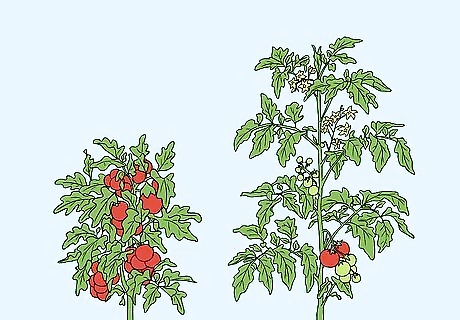
Know how large your plant is likely to grow. When picking a type of tomato, do some research to figure out roughly how big the plant will get. You can look at its label, talk to a plant store employee, or do research online. There are 2 types of tomato plants that are typically very different in size: determinate or indeterminate. Determinate plants only grow to about 3 feet (0.91 m) tall. Indeterminate plants can grow between 6–10 feet (1.8–3.0 m) tall. Determinate tomato plants need less support. They are more naturally bushing and smaller, so they can support themselves better than the vine-like indeterminate plants. These can typically be supported by a small tomato cage. If you have a limited amount of space or a pot that is less than 5 gallons (0.67 cu ft), you should consider planting a determinate plant.
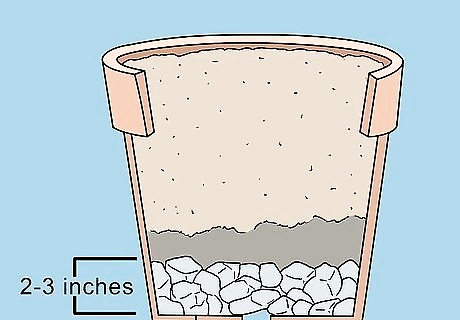
Make sure the pot provides a sturdy base. Part of supporting a growing tomato plant is ensuring that the base is heavy enough to support it. A lightweight pot is likely to fall over when the plant gets large, no matter how much you support the branches. The easiest way to weigh down a pot is to cover the bottom of it with 2–3 inches (5.1–7.6 cm) of gravel or rocks before adding the soil and the plant. Adding rocks or gravel to the bottom of the pot has the added benefit of providing good drainage for the plant.
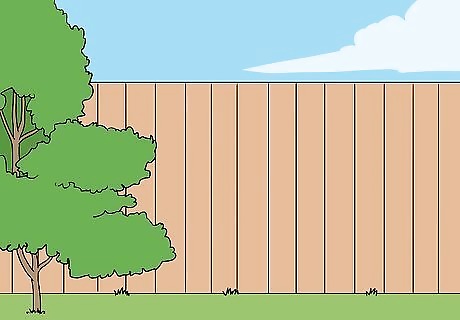
Place the pot against a supportive surface. In addition to having a heavy pot, it's a good idea to put the pot against a sturdy surface, such as a wall. This will give the pot some additional support if the plant gets particularly large. For example, you can place the tomato pot against a retaining wall, fence, or trellis in your yard. Placing the pot against a solid surface can also protect it from the wind.
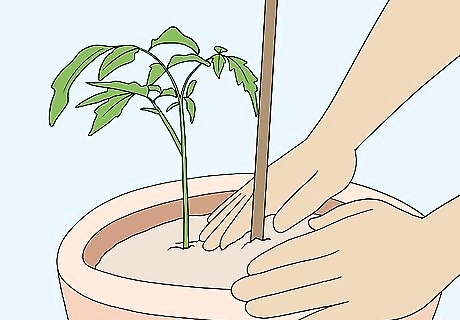
Insert supports when you plant the tomato. It’s best to install your support stake or cage when you first put the plant in the pot. This ensures that the plant always has the supports to rely on as it grows. It also minimizes the risk of injuring the root system of the plant when the stakes or cage tines are inserted. Placing a large cage, stake, or tripod around a very tiny plant can look a little funny at first. Just know that your plant will grow into the support system and will rely on it at is develops.
Using a Tomato Cage

Find a tomato cage that will fit in your pot. Tomato cages come in a wide variety of sizes and shapes. Pick one that is the same diameter as the pot you will be using. The cage should be at least 3 feet (0.91 m) tall. You also need to make sure that the legs of the cage are at least as long as the pot it tall. The goal is to have the legs of the cage reach the very bottom of the pot when they are inserted. If you are using a square pot, look for a square tomato cage. These are harder to find than round tomato cages, but are usually available at specialty nurseries and garden stores.
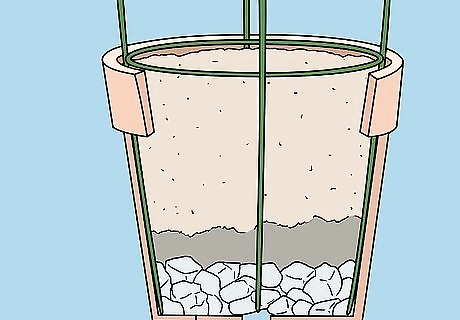
Shape the cage legs to your pot. Cut the legs of the cage to the depth of the pot, so that the bottom ring of the cage touches the soil when the legs hit the bottom of the pot. You can also bend the legs so that they fit the shape of the pot better. For example, for a typical tapered pot you should bend the bottom of the legs of the cage in towards each other a bit. The goal is to have the tips of the legs hit the bottom inner edge of the pot when the cage is inserted. Having the bottom ring of the cage touch the soil gives the cage more support. As the plant grows, the cage will be able to support the weight of the plant in any direction.
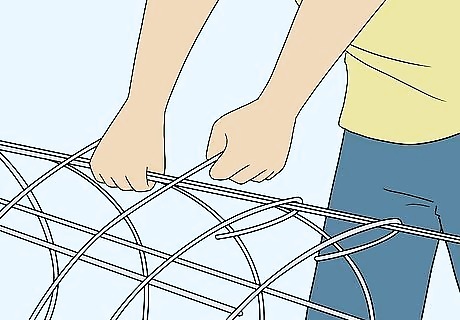
Create your own cage. If you can't find a cage that works for your pot, or you just don't want to buy one, you can make your own. Tomato cages can be made out of metal netting or concrete reinforcing wire, which is available at most hardware and home improvement stores. Start by cutting a piece of the wire mesh long enough to make a cylinder. The length you cut should make a cylinder the same diameter as the top of the pot. Then cut the bottom horizontal pieces so that you are left with long vertical wires that can be inserted into the soil. Finally, bend the piece into a cylinder. The seam where the 2 sides meet can be tied together with twine or rope.
Staking Your Plants
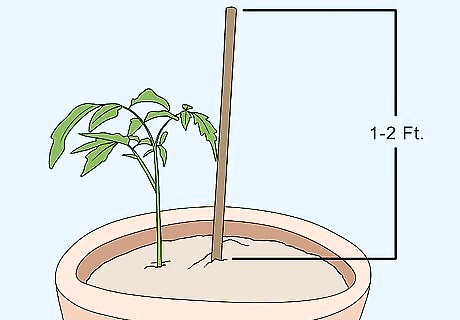
Put 1 stake at the center of the pot. You can support a small tomato plant by placing 1 stake right next to its stem. Use a stake that is long enough to go to the bottom of the pot and stick up out of the soil 1–2 feet (0.30–0.61 m). Once the stake is in place, you should tie the stem to the stake with a piece of twine, plant ribbon, or plant wire. Use a loose loop that doesn't tie the plant to tightly. This will support the plant as it grows. Using one stake protects a young plant from being toppled over or broken off by strong winds or heavy rains. When inserting the stake, try not to damage the root ball of the plant. Gently insert the stake, and try another spot if you encounter a lot of resistance.
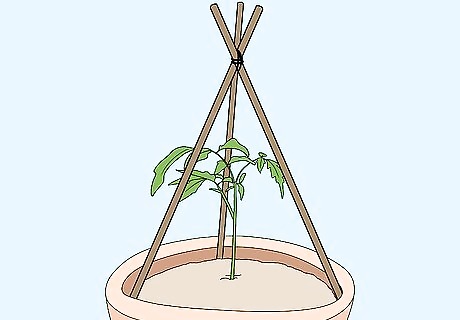
Use a tripod to support your plant. If you want to create a strong support system for your tomato plant, you can use a tripod made out of 3 or more stakes. The bottoms of these stakes should be inserted around the edge of the pot with even spacing between them. Then the tops of the stakes should be tied together with a piece of twine or rope. The tripod will support a large amount of weight as the tomatoes develop because the weight is distributed among the stakes.
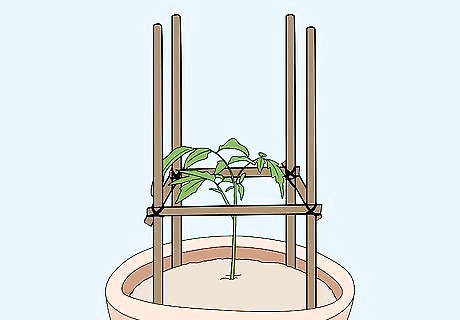
Create a unique support system. You can use a variety of creative designs to make a support system just to your liking. You just need to ensure that the plant can be supported effectively at every stage of its growth. For example, you can use squares of concrete reinforcing wire that are the same width as the pot. These could be held horizontally on stakes, so that the tomato plant would grow up through the holes. You could also insert stakes around the inside edge of the pot and then tie rope or wire diagonally between the stakes. Use a piece of sturdy yard art or a small trellis you already have to support your potted tomato plant.
Supporting Tomatoes as They Grow

Tie up the center stalk of the plant. As your tomato plant grows, it's important to keep its center well supported. If you don't, the weight of the branches and fruits can topple the entire plant. To prevent the plant from leaning, the center stem of your tomato plant should be tied every 6–8 inches (15–20 cm) to keep it growing upright. Use a loose knot that goes around a stake or a piece of the cage in addition to the main stem of the plant. Use plant rope or ties that are made to tie up plants. These are available at home improvement and gardening stores. It is especially important to keep a potted tomato plant growing upright. If it leans too far over, it could topple the whole pot. If you see the middle stem leaning to the side, tie it to the support frame to straighten it out.

Support individual branches. As your tomato plant grows, you can train the branches so that they are supported by the cage. Once a branch reaches the sides of the cage, feel free to move it so that it is sitting on top of one of the rings. If you are using stakes, tie up each branch that reaches the stakes so that they are supported. Tie the branches loosely. The branches will continue to grow in diameter, and tight ties can deter this growth. Large branches will get heavy and begin to sag, even if they are already supported part way down their length. Tie these long branches a second time back to the cage or the stakes when you notice this, as too much weight can break a branch off your plant.
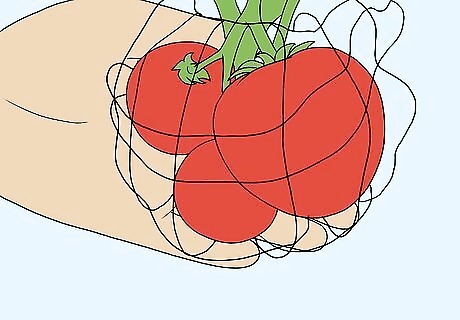
Hold up individual large tomatoes. If you are growing cherry tomatoes, you won't need to support individual fruit. However, if you are growing larger tomatoes, really large ones might need to be supported individually. If they fall to the ground, they’ll rot and get eaten by insects. You can use bird netting to hold up individual tomatoes that you really don't want to lose. This has the added benefit of protecting the fruit from animals that might want to eat it.

Add exterior supports if the plant gets too large. If you are successful at growing an extremely large plant, you may be forced to add supports outside of the pot. If the pot is against a surface, such as a railing, you can use this for additional support. If not, you may need to set up a tripod on the ground outside of the pot. One of the benefits of growing tomatoes in pots is that it cuts down on the number of pests that can damage your plants. If you put supports that touch the plant outside of the pot, just be aware that this may create a new way for pests to reach your tomatoes.
















Comments
0 comment